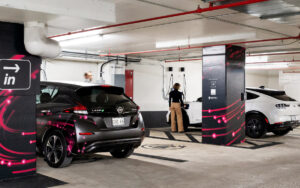As multi-unit residential building owners face accommodating electric vehicle charging infrastructure, a new SWTCH vehicle-to-grid pilot is gathering data on the possibilities of a smart, bidirectional system

SWTCH vehicle-to-grid pilot aims to optimize load management by focusing specifically on multi-residential buildings. Image courtesy of IBI Group
As multi-unit residential building owners face accommodating electric vehicle charging infrastructure, a new SWTCH Energy vehicle-to-grid pilot is gathering data on the possibilities of a smart, bidirectional system
This article is presented by SWTCH Energy

As the demand for electric vehicles increases across Canada, so too is the need for convenient, reliable, resilient charging infrastructure and energy load management. In fact, at this point, the need is urgent.
In the next few years, there will be a sharp rise in the number of cars plugged into electrical outlets at residences and workplaces. While EV charging in single-family homes is a fairly simple undertaking, in high-density urban settings, with many people living in multi-unit residential buildings (MURBs) the challenges start to mount. This is a barrier to adoption.
The solution in the case of MURBs and commercial buildings is implementing a strategy for peak load management, smart charging and leveraging resources.
SWTCH Energy, a Toronto-based end-to-end EV charging and energy management solution provider, has concentrated its business on offering just that service through blockchain technology to help manage a building’s electric load. Now, the company is moving into new territory with a three-year pilot program that is looking at ways to reduce the strain of charging with SWTCH vehicle-to-grid technology, bring cost benefits to a building and promote energy efficiency.
Off-peak vs on-peak hours
In a 9-storey office building owned by Slate Asset Management, in the heart of Toronto, SWTCH, in collaboration with IBI Group, will be studying the impact a Nissan Leaf can have on the building’s electrical load both as a power-drawing and an energy storage unit.
The key areas to be studied include:
- The ability to discharge the energy from the vehicle using the V2G charger, and
- The ability to slow down the Level 2 chargers when market signals are received from the Independent Electricity System Operator (IESO).
Based on the time of use rates (broken down by off peak, mid peak and peak tiers, in Ontario) SWTCH vehicle-to-grid technology will determine how the Leaf — and its energy — is to be used. During off-peak hours, the vehicle will be charged using electricity offered at the cheapest daily rate. During on-peak hours, the car will, using bi-directional charging technology, discharge its stored off-peak electricity to power the building itself and support the EV Level 2 chargers in use and charging other vehicles.
SWTCH hopes the pilot will demonstrate not only how off- and on-peak energy loads can be managed, but that by appropriately leveraging resources like EVs some of the high costs of upgrades to a building’s electrical infrastructure could be deferred or avoided entirely.
It’s an approach that, if successful, could offer a transformative solution to MURBs and commercial buildings while opening up access to charging to a demographic of potential EV drivers that may have been completely blocked from transitioning or made hesitant due to charging infrastructure uncertainty. Building owners, in turn, can feel reassured that their electrical input and output are being managed in an efficient way that offers the maximum benefit to all stakeholders.
Visit the SWTCH website for more information.






